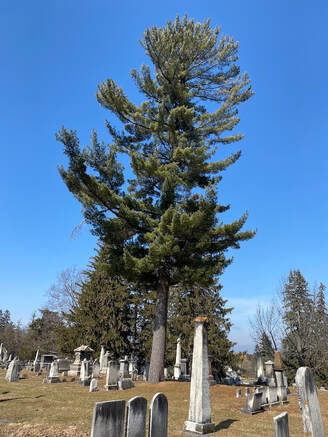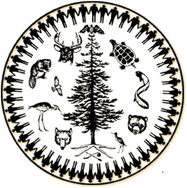 At one time, the Eastern White Pine (Pinus strobus) dominated the northeastern forests of the U.S. and had multiple uses for both the Native Americans and the colonists. Its durable wood and straight trunk made it a valuable commodity during colonial times in the U.S. Because of its value, the white pine was at the center of numerous skirmishes between colonists and the men in charge of enforcing English laws on harvesting white pines for private use. White pines grow rapidly and have longevity, some living as long as four hundred years. When the colonists arrived in New England in the early 1600s, they found virginal forests of pine and discovered trees towering over 200 feet in the air with bases several feet in diameter. They also noticed how the Native Americans used the trees for utilitarian as well as medicinal purposes. Algonquins steeped the needles and inner bark to make a tea to prevent scurvy earning them the nick-name 'bark-eaters'. The Haudenosaunee (Iroquois - Five Nations) culture refer to the white pine as the Tree of Peace. Historical accounts of a peace treaty agreed upon between the Mohawk, Onondaga, Seneca, Cayuga, and Oneida tribes, occurred after a meeting under the canopy of this majestic tree. And in a testament to the significance of the white pine to their culture, (the five needles represent the tribes) the tree is at the center of the Haudenosaunee seal. Due to its straight growth and superior strength, the English Crown made grand plans to harvest the pines and export them as masts for the Royal Navy. By the early 1700s the Crown had placed restrictions on the cutting of white pine, blazing them with the King's Arrow. The surveyors hired by the Crown penalized colonists for cutting down or using pines for their own purposes, which the colonists resented. This intrusion on their private property rights led to constant battles between the enforcers of the laws and the property owners in New England. Many committed acts of defiance against the surveyors. They'd cut the trees and have them milled before a surveyor could blaze them. Some set fire to the trees, rendering them useless for masts but still good enough for use in construction. The colonists also resented having to harvest the white pine for the Crown. The work was harsh and often resulted in death when a felled tree landed on the men doing the cutting. In addition to the felling, the harvesters had to create primitive roads, cutting swaths of trees deep into the interior, so they could transport the logs. Once cut, they used oxen to drag the enormous trunks to a river where the current would carry them to the nearest port. This journey proved treacherous and put their work oxen at risk. Much like the taxes on economic commodities, England's repressive laws on white pine use united the colonists against the Crown. Indeed, a rebellion dubbed the Pine Tree Riot in New Hampshire occurred months before the infamous Boston Tea Party incident. By the time the Revolutionary War broke out, England was dependent on the northeastern white pine for its Royal Navy. Hence, when they lost access to New England's forests, they had to shift to importing Riga firs from the Baltics, an inferior tree for making masts and a blow to the Royal Navy. Indeed, some historians believe the white pine played a role in the eventual victory for the colonists. The next time you see a white pine growing in the forest (or as I have pictured here in a local cemetery), consider it has a history going back as long as it may have been alive. Sources: Eric Rutkow. American Canopy: Trees, Forests, and the making of a Nation. Scribner. 2012 Vietze, Andrew. White Pine and a Tree that Made a Nation. 2017 Globe Pequot Press.
0 Comments
Leave a Reply. |
AuthorSheila Myers is an award winning author and Professor at a small college in Upstate NY. She enjoys writing, swimming in lakes, and walking in nature. Not always in that order. Archives
April 2024
CategoriesAll Adirondacks Algonquin Appalachia Award Cades Cove Canada Chestnut Trees Christmas Civilian Conservation Corps Collis P. Huntington Creativity Doc Durant Durant Family Saga Emma Bell Miles Finger Lakes Great Depression Hell On Wheels Historical Fiction History Horace Kephart Imagination National Parks Nature Publishing Review Screenplay Short Story Smoky Mountains Snow Storm Stone Canoe Literary Magazine Thomas Durant Timber Wilderness World War II Writing |
|
|
All materials Copyright 2022
Any reproduction, reprint or publication without written consent of author prohibited. |

 RSS Feed
RSS Feed